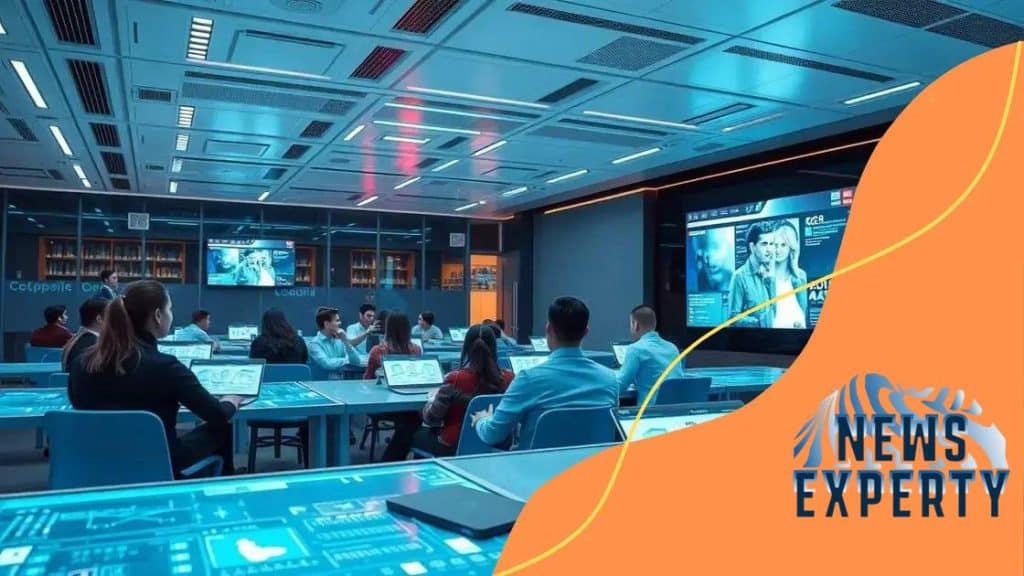Online higher education in 2025: trends to watch

Anúncios
Trends in student engagement and retention highlight the importance of interactive learning, personalized paths, and supportive communities to enhance academic success and ensure students feel connected to their educational journey.
Online higher education in 2025 is set to evolve at a remarkable pace, driven by innovative technologies and changing student expectations. Are you ready to dive into what’s on the horizon?
Anúncios
Emerging technologies in online education
Emerging technologies are reshaping the landscape of online education in profound ways. These innovations are not just enhancing the learning experience; they are also making education more accessible and engaging for students worldwide. From virtual reality to artificial intelligence, let’s explore how these advancements are changing the game.
Artificial Intelligence in Learning
Artificial intelligence (AI) is playing a crucial role in personalizing education. AI systems can analyze student performance and tailor lessons to meet individual needs. This ensures that each learner progresses at their own pace.
- Adaptive learning platforms that adjust content based on student performance.
- AI tutors that provide support outside traditional classroom hours.
- Automated grading systems that save teachers time while providing immediate feedback.
Moreover, AI can help identify students who may be struggling, allowing educators to intervene early. This proactive approach can significantly improve academic outcomes.
Anúncios
Virtual and Augmented Reality Experiences
Virtual Reality (VR) and Augmented Reality (AR)
Imagine exploring ancient ruins in a history class or conducting a virtual chemistry experiment! These experiences make learning exciting and memorable. Additionally, AR can overlay information onto the real world, enriching lessons with context and interactivity. Students are not just passive recipients of information; they become active participants in their education. Another emerging technology that holds promise for online education is blockchain. This decentralized ledger system can securely store academic credentials, making it easier for students and employers to verify qualifications. As trust becomes increasingly important in the digital space, blockchain can provide a transparent solution that benefits everyone involved. Using blockchain for credentialing reduces instances of fraud and ensures that educational achievements are accurately represented. It gives students the confidence that their hard work will be recognized in the job market. In summary, as we look at the future of online education, we see that emerging technologies are leading the charge. These advancements not only enhance learning experiences but also simplify administrative processes and increase accessibility. Embracing these innovations will be key to preparing both students and institutions for a successful future. The shift towards hybrid learning models is transforming education by blending traditional classroom methods with online learning. This approach allows for more flexibility and accessibility, catering to diverse learner needs. As students and educators embrace this shift, we see new opportunities for engagement and collaboration. Hybrid learning combines the best of both worlds, offering various advantages for students. This flexible model supports different learning styles and schedules. These benefits lead to improved academic performance. Students can focus on areas where they need more help while enjoying the structure of in-person classes. Technology plays a vital role in implementing effective hybrid learning models. Tools like video conferencing, collaborative software, and learning management systems facilitate seamless transitions between online and in-person education. Educational institutions are adopting various technologies to enhance the student experience. For instance, many use platforms that allow easy access to resources and communication with instructors. This accessibility fosters a supportive learning environment. Moreover, technology helps teachers monitor progress and adjust instruction to better fit student needs. By utilizing data analytics, educators can gain insights into which teaching methods work best. While hybrid learning provides numerous benefits, it also poses challenges. Ensuring that all students have access to reliable internet and devices is essential for success. Additionally, instructors must receive proper training to effectively engage students in both settings. Balancing the online and in-person components can be difficult, as educators need to manage diverse group dynamics. However, with good planning and support, these challenges can be overcome, leading to enriching learning experiences for all. In summary, the shift towards hybrid learning models marks an exciting evolution in education. By combining traditional methods with modern technology, we can create an environment that is more engaging and adaptive to the needs of today’s learners. In today’s fast-changing world, acquiring key skills is essential for success in the future job markets. As technology continues to evolve, the demands of employers shift. Understanding which skills are needed helps learners prepare for their careers ahead. Critical thinking is a skill that enables individuals to analyze information objectively and make reasoned decisions. Employers highly value this skill because it helps teams navigate complex challenges. Similarly, problem-solving means identifying issues and developing effective strategies to address them. Being able to think critically and solve problems will set candidates apart in competitive job markets, allowing them to tackle various obstacles efficiently. Digital literacy is now a fundamental skill for almost every job. As workplaces become more technologically advanced, understanding how to use digital tools is crucial. From software applications to online communication platforms, proficiency in these tools is expected. Moreover, digital literacy includes knowing how to evaluate online information critically and stay safe while navigating the web. This skill set prepares individuals not only to work effectively but also to adapt to future technological changes. In many roles, working with others is essential. Collaboration involves sharing ideas and resources to achieve common goals. Good teamwork skills are vital for building relationships and ensuring successful projects. Employers look for candidates who can work seamlessly with diverse teams and respect different perspectives. Individuals who excel in these areas contribute positively to workplace culture, enhancing productivity. With these key skills, job seekers can position themselves favorably in the future job markets. Each skill complements the others, forming a strong foundation for academic and professional success. Education institutions are constantly evolving to meet the changing demands of students and the job market. Adapting to these changes is crucial for institutions to provide relevant and effective education that prepares learners for the future. Institutions are increasingly incorporating technology into their curricula. By integrating online tools and resources, they enhance the learning experience. This shift allows for more interactive and flexible learning environments. These technological advancements cater to diverse learning styles, making education more accessible and engaging for students. To keep pace with the job market, educational institutions are revising their curricula to include skills that are in high demand. This often means adding courses in data analysis, cybersecurity, and other emerging fields. Institutions are also collaborating with industry leaders to understand the skills that employers value most. This partnership ensures that students graduate with relevant knowledge and the ability to apply their learning in real-world situations. In addition to technical skills, programs focusing on soft skills like communication, teamwork, and adaptability are also becoming increasingly important. Flexible learning options are essential as students seek balance in their lives. Many institutions now offer part-time, online, and hybrid programs. This flexibility allows learners to tailor their education around their work and personal commitments. As a result, students are more likely to persist and complete their studies. Institutions that can provide such adaptable options are attracting more students and enhancing their enrollment. By actively responding to the changing demands of education and the workforce, institutions not only maintain their relevance but also foster a culture of continuous improvement. This adaptation is vital for developing competent graduates equipped to succeed in their chosen careers. Trends in student engagement and retention are crucial as educational institutions strive to improve learning outcomes. With the rise of online and hybrid learning, understanding what keeps students motivated is more important than ever. One significant trend is the shift towards interactive learning experiences. Students are more engaged when lessons involve active participation. This can include collaborative projects, group discussions, and hands-on activities that promote teamwork and critical thinking. By making learning interactive, institutions can create a dynamic environment that keeps students interested and invested in their education. Another trend is the increase in personalized learning paths. Recognizing that each student learns differently, educators are designing programs that allow for more tailored experiences. This approach helps students focus on their strengths and address their weaknesses. Tools like learning management systems facilitate this personalization by tracking progress and adapting materials to meet individual needs. When students receive instruction that resonates with them, they are more likely to feel engaged and less likely to drop out. Creating supportive learning communities plays a vital role in retaining students. This includes fostering relationships between students, faculty, and staff that encourage open communication and collaboration. Support networks can provide help, mentorship, and guidance, making students feel more connected to their educational environment. Additionally, institutions are investing in mental health resources and counseling services to support students’ emotional well-being. When students feel supported academically and personally, they are more likely to stay enrolled and succeed. Overall, the trends in student engagement and retention highlight the importance of creating a responsive and supportive educational experience. Through interactive learning, personalized paths, and strong communities, institutions can better meet the challenges of today’s learners, ensuring their success. In conclusion, the trends in student engagement and retention show how essential it is for educational institutions to adapt to the changing needs of learners. By developing interactive learning experiences, fostering personalized paths, and building supportive learning communities, schools can enhance the educational experience. These strategies not only motivate students but also help them feel more connected and equipped to succeed. As institutions continue to evolve, focusing on these key areas will ensure that students thrive in their academic journeys. Interactive learning involves engaging students through activities such as group work and hands-on projects. It’s important because it increases motivation and helps retain information better. Personalization allows learning experiences to be tailored to individual needs, making lessons more relevant and engaging for each student. Supportive communities foster relationships and provide help, making students feel connected to their educational environment, which enhances retention. Institutions can use learning management systems to analyze data on student performance and adapt teaching methods accordingly to improve outcomes.Blockchain for Credentialing
The shift towards hybrid learning models
Benefits of Hybrid Learning
Technology’s Role in Hybrid Learning
Challenges of Hybrid Learning
Key skills needed for future job markets

Critical Thinking and Problem Solving
Digital Literacy
Collaboration and Teamwork
How institutions will adapt to changing demands
Incorporating Technology
Curriculum Revisions
Flexible Learning Options
Trends in student engagement and retention
Interactive Learning Experiences
Personalized Learning Paths
Supportive Learning Communities
FAQ – Questions about Trends in Student Engagement and Retention
What is interactive learning and why is it important?
How can personalization improve student engagement?
What role do supportive communities play in student retention?
How can institutions track student progress effectively?





